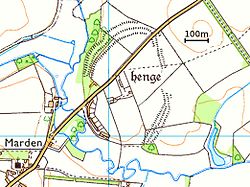Marden Henge
Marden Henge (also known as Hatfield Earthworks) is the largest Neolithic henge enclosure discovered to date in the United Kingdom.[1] The monument is located in Marden, Wiltshire, within the Vale of Pewsey between Avebury and Stonehenge,[2] and together with these and other major Prehisotric sites of the county it forms part of a declared "World Heritage site" known as 'Stonehenge, Avebury and Associated sites'.
The site is today under the care of English Heritage.
Description
The monument is roughly oval in shape, and is enclosed by a typical bank and internal ditch arrangement constructed on the east, north and north-west sides and by the River Avon to the south and west.[3][4] It encompasses an area of 35 acres
Antiquarian accounts of the site describe a huge mound within the enclosure called Hatfield Barrow, which collapsed after excavation by William Cunnington in the early 19th century. Today, Marden Henge has been damaged by ploughing, and no longer has any standing stones.

Around half a mile to the south, archaeologists have detected the presence of another henge known as Wilsford Henge.[5]
Archaeology
The area was designated as a scheduled monument in 1953.[6] The site was excavated by Geoff Wainwright in 1969; he excavated the north entrance and found a timber circle, and grooved ware pottery, similar to that found at Durrington Walls. The finds are at Wiltshire Museum in Devizes, where there is also a small display.
In 2010, the henge and surrounding area were investigated through aerial, geophysical, and field survey.[7] During the dig, a Neolithic building was discovered, described as the best preserved Neolithic building in Britain.[8]
The site is included in a three-year investigation of the Pewsey Vale, beginning in 2015, by the Department of Archaeology at the University of Reading.[9][10]
Outside links
- Location map: 51°19’24"N, 1°52’12"W
- Map; SU091582
- Hatfield Earthworks (Marden Henge) – English Heritage
- Hatfield Barrow - Cunnington's description of the excavations at Wiltshire Heritage Museum
- Blog entry highlighting the Marden excavation finds on the website of Wiltshire Heritage Museum
References
- ↑ Dyer, 2001. p. 191.
- ↑ Leary & Field, 2010. p. 10.
- ↑ Dyer, 2001. p. 191.
- ↑ Castleden, 1992. p. 219.
- ↑ Marden Environs Geophysical Survey – Historic England
- ↑ National Heritage List 1014617: The Hatfield Earthwork
- ↑ "Work starts on prehistoric Marden Henge in Wiltshire". BBC News. 28 June 2010. http://www.bbc.co.uk/news/10433037. Retrieved 23 July 2010.
- ↑ "Marden Henge dig uncovers 4,500-year-old dwelling". BBC News. 19 July 2010. http://www.bbc.co.uk/news/uk-england-wiltshire-10684042. Retrieved 23 July 2010.
- ↑ "About the Vale of Pewsey project". University of Reading. https://www.reading.ac.uk/field-school/About/afs-about-pewsey.aspx. Retrieved 16 March 2016.
- ↑ Smith, Roff (6 August 2015). "This Ancient British Monument Was 10 Times Bigger Than Stonehenge". National Geographic Society. http://news.nationalgeographic.com/2015/08/150806-marden-henge-stonehenge-leary-britain-archaeology/. Retrieved 7 August 2015.
- Castleden, Rodney (1992). Neolithic Britain: New Stone Age Sites of England, Scotland, and Wales. London: Routledge. ISBN 978-0-415-05845-2.
- Dyer, James (1 May 2001). Discovering Prehistoric England (2nd ed.). Princes Risborough: Shire Publications. ISBN 978-0-747-80507-6.
- Leary, Jim; Field, David (2010). "Recent work at Marden Henge, Wiltshire". Research News (English Heritage) (15). SSN 1750-2446.